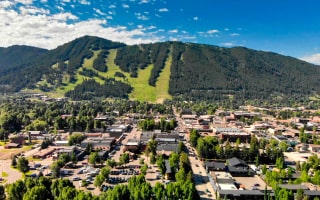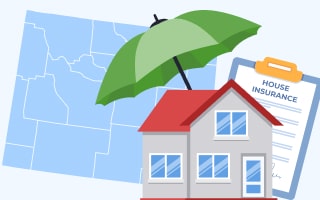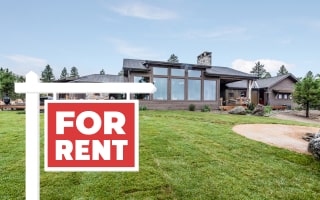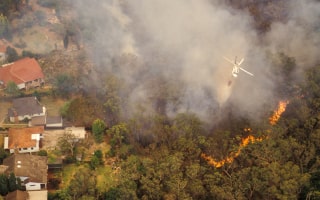Homeowners Insurance in Wyoming

Wyoming is known for several natural wonders, like the famous Yellowstone National Park with its "Old Faithful" geyser, hot springs, and abundant wildlife, cowboys, and rodeos. Located in the west, Wyoming is subject to turbulent weather like floods, earthquakes, wildfires, and harsh winter storms, which can cause devastating property damage and result in costly claims and insurance losses. Since 1953, Wyoming has had 32 federally declared disasters, and the rate of disasters per 1 million people is 54.56.
In addition to numerous claims for tornado damage, wildfires, flooding, and earthquakes, Wyoming residents also file homeowners insurance claims for water damage, freezing, fire and lightning, theft, and vandalism.
No U.S. state requires homeowners to purchase any type of homeowners insurance. However, insurance firms and experts agree that anyone who owns property should have some kind of protection. If you borrow money to buy a house in Wyoming, your lender will require that you purchase specific coverage limits and keep them on the house for the life of the loan.
As of October 2024, the national average for homeowners insurance is $2,728 a year or $227 monthly. Wyoming homeowners pay an average of $1,547, far less than the national average, despite the possible perils.
Types of Homeowner Insurance Coverage Available in Wyoming
United States insurance carriers decide where to operate and what types of coverage make the most sense based on the potential natural disasters. In Wyoming, there are plenty of firms available, and the types of coverage to choose from include:
-
Dwelling: Your dwelling coverage protects the structure of your home (roof, foundation, walls, plumbing, wiring, etc.) against covered perils. If your home is damaged or destroyed, dwelling insurance will pay to repair or replace it.
-
Other Structures: Other structures' coverage protects your detached items like fences, pools, hot tubs, garages, and sheds. It will pay to replace them after a disaster.
-
Personal Property: Personal property coverage pays to replace your belongings should they be stolen or destroyed in a covered event.
-
Liability: If someone gets hurt on your property due to your negligence, liability insurance will pay your legal bills up to a specific limit.
-
Medical Payments: If anyone is injured on your property, medical payments insurance will pay their medical bills.
-
Additional Living Expenses (ALE): If you must leave your home after a covered disaster, ALE insurance will pay for your food, lodging, pet boarding, furniture rental, travel expenses, and more until you can return home.
Wyoming residents should also consider a flood policy, as flooding is an issue. Also, consider a possible umbrella policy to fill in any gaps in coverage.
FEMA (Federal Emergency Management Agency) manages the National Flood Insurance Program (NFIP) through a network of 50 providers across the U.S.
Since most homeowners insurance does not cover floods, this supplemental coverage can repair damage and replace items after a flood. Depending on the options you choose, it can cover the building and/or your personal belongings. This program is available to homeowners, renters, and businesses. Learn more about the program on FEMA's website.
Home Insurance and Natural Disasters
Global warming has caused distress across the country, especially within the home insurance industry. Climate change and frequent natural disasters are the main drivers of insurance rates today. Over the past five years, rates have spiked by 34% and as high as 60% in some areas. Rates in Wyoming are expected to rise by 1% this year and possibly continue into the future.
Wyoming is subject to extreme weather, like floods, earthquakes, wildfires, and harsh winter storms, which can devastate property. From 1905 to 2024, Wyoming has incurred $126.7 million in flood damage. Even one flood claim costs insurers an average of $11,650. From 2023 to 2024, Wyoming had 1,301 wildfires. One fire incident costs insurance providers an average of $77,340. An average wind and hail damage claim costs $11,695 per incident. From 2015 to 2019, Wyoming insurance providers lost a total of $149,107,600. From 1980 to 2024, Wyoming had 31 billion-dollar disasters, which is about average compared to other states.
How Can I Save on Homeowner Insurance Premiums in Wyoming?
Everyone is looking to save a buck here or there. Home insurance premiums are rising steadily, making it difficult for some homeowners to afford coverage. The best way to save money on homeowner insurance premiums is to fully understand what impacts them. The factors in Wyoming are:
-
Location: Your location matters the most. If you live in an area with frequent natural disasters, your likelihood of filing claims is higher, and your rates will be as well. The same is true if you live in a city where crime is higher.
-
On-site Risks: The more risks you have on your property (pools, hot tubs, treehouses, etc.), the higher your rates will be.
-
Your Deductible: The higher your deductible, the lower your rates will be. Conversely, the lower the deductible, the higher your rates.
-
Your Credit Score: People with a high credit score pay much lower premiums than those with poor credit.
-
Condition of Your Home: Houses in good condition will earn lower rates than those in disrepair.
-
Size & Age of Your Home: The size of the house matters; the more significant the home, the more it will cost to rebuild after a qualifying event. Newer homes cost far less to insure than older homes.
-
Previous Claims: If you have a history of filing claims, you will pay more than someone who doesn't file claims.
-
Coverages: The more coverage you purchase, the higher your rates.
-
Financed vs. Owned: When you finance your home, your lender dictates your coverage levels. If you own it outright, you get to decide.
-
Construction Materials: Homes built with code-friendly materials like fire-retardent shingles and siding will pay less for insurance premiums.
-
Pets: Some types of pets are dangerous and will mean you pay more for your insurance rates.
You can save on homeowners insurance by following these tips:
- Avoid High Risk: To save money, remove anything on your property that poses extra risk.
- Raise Your Deductible: Increase your deductible as comfortably as possible to reduce your premiums.
- Improve Your Credit Score: Improve your credit to save money on your rates.
- Install a Security System: Install a high-end security system to make your home safer and earn lower rates.
- Make Home Improvements: Replace the roof and install storm windows and shutters for reduced insurance rates.
- Don't File Small Claims: Don't file for small claims; wait for the big ones. Even one claim could increase your rates by 20%.
- Ask for Discounts: Ask your provider for other discounts they offer that you might qualify for.
- Ask Around: Ask friends and family for recommendations for solid insurance firms that offer low rates.
Home Insurance Discounts in Wyoming
Home insurance protects your home against disasters. Once you find a provider, you select your coverage and buy a policy. After a qualifying event, the insurance company pays to repair or rebuild your home to its normal condition. Most home insurance policies also include personal property protection, liability and medical payments coverage, other structures, and loss of use protection (ALE).
You can quickly get a policy by selecting a provider and contacting them through their website (apply online) or calling their 800 number. You may also want to find a local agent to help you select coverage for your specific situation. Once you purchase the policy, you must pay the first year in advance. After that, you can pay monthly through your mortgage escrow or once a year, depending on whether you have financed your home or not.
The most common typical home insurance discounts offered by most insurance firms include:
- Fire-Safety Discount: Install sprinklers, smoke alarms, and fire extinguishers to earn a discount on your home insurance.
- Early Quote Discount: If you request a quote well before you need it, your provider may offer you a discount for being proactive.
- Senior Discount: Many firms offer discounts on home insurance to seniors of a specific age.
- Military Discount: Most insurance providers discount active military personnel and vets.
- Occupational Discount: Some professions, like firefighters and teachers, also get discounts.
- Claims-Free Discount: Stay claims-free for as long as possible to earn discounts from your insurance provider.
- Safety Discount: Make your home safer with a home security system to avoid theft, vandalism, and break-ins, and you could earn discounts.
- Bundling Discount: Bundle multiple policies together for a discount.
- Paperless Discount: Go paperless for your insurance statements, and your provider will give you a discount.
- Autopay Discount: Sign up for autopay and earn a small premium discount.
- New Roof Discount: Install a more storm-resistant roof, and your provider will give you a discount.
- Non-smoking Discount: Non-smokers have less fire risk and get lower rates than smokers.
- Smart Home Discount: Install smart home devices to make your home more efficient, monitor for disasters, and earn a discount.
- Green Discount: Install specific eco-friendly devices, and your provider may give you a discount.
Common Rates Offer by Homeowners Insurance Firms
New homes cost far less to insure than older homes. Sometimes, you can save up to 40% or even 26% if the house is five years old or younger. Newer homes are constructed according to current building codes using more fire-resistant materials, making them easier to rebuild after a disaster. In Wyoming, owners of new homes pay an average of $960 a year, or $80 a month. Of course, your actual rates will depend on your age, credit score, insurance firm, and other factors.
Top 10 Home Insurance Firms in Wyoming and Average New Home Savings
| Company | % savings |
|---|---|
| Nationwide | 76% |
| Amica Mutual Insurance | N/A |
| State Farm | 51% |
| Travelers | 63% |
| Allstate | 47% |
| USAA | 54% |
| Chubb | N/A |
| Liberty Mutual | N/A |
| Plymouth Rock Assurance | N/A |
| The Hartford | N/A |
Home Insurance and Renovations in Wyoming

An extensive home renovation can transform your home and make it spectacular, but these updates can also affect your home insurance rates. Some upgrades increase risk, value, or both and raise your rates. Others may decrease risk and your rates, while others have no effect.
![]() Home Renovations that Increase Rates
Home Renovations that Increase Rates
Some home renovations that increase your rates include:
- Updated Kitchen/Baths: Updating your kitchen or bathrooms can make an instant difference and add immense value, but it will also raise your rates.
- Adding More Room: Adding square footage to your home can make it roomier for everyone, but it will also cost more to rebuild after a disaster, so your rates will increase.
- Building a Koi Pond: Koi ponds can be very serene, but they also pose a risk, and your rates will increase if you add one.
![]() Home Renovations that Decrease Rates
Home Renovations that Decrease Rates
Some home renovations that decrease your rates include:
- Replace Your Plumbing: Old plumbing can leak and burst pipes, causing severe water damage. Upgrading your plumbing can eliminate these issues and help to decrease your home insurance costs.
- Earthquake Resistance Retrofits: Anyone who lives in an earthquake-prone area should reinforce their home with straps, ties, and shatterproof windows. Insurers also reward you with money off your premiums.
- Sprinkler System: Installing a sprinkler system will make your house much safer and fire-ready, and your insurance company will lower your rates as a result.
Generally, replacing your roof is a good thing. If you replace it with high-end materials like metal, your insurance rates may go up, but the safety features may cancel them out; it depends on your insurer.
Homeowners insurance does not cover regular home updates. It only pays to repair or rebuild your home after a disaster, not maintenance or elective renovations. However, those are covered if someone steals from you or gets hurt during renovations. Other things not covered are animal damage, pest infestations, rodents, mold, fungus, and sewer issues.
Always speak to your insurance agent before making any major renovations. They will help you understand the impact on your rates and coverage. Your agent may want to inspect the work once it is done to re-evaluate your coverage limits and make adjustments.
Wyoming Renters' Insurance

Renters insurance is homeowners insurance for people in Wyoming who rent houses, apartments, and condos. However, it differs from homeowners as it has no dwelling coverage. That must be covered under the owner's policy. Mostly, renters insurance pays to replace your personal belongings if they are destroyed by a qualifying event or stolen. Most renters policies also cover liability, medical payments, and loss of use (ALE). Some covered events include fire, smoke, lightning, windstorms, theft, and vandalism. Some things renters insurance will replace include:
-
Furniture
-
Clothing
-
Small Appliances
-
Bath Items
-
Bedding
-
Electronics
-
Sports Equipment
Insurance providers price renters insurance based on three main factors:
-
Location: Renters insurance costs less in safer areas. However, high crime rates and frequent disasters mean you will pay more.
-
Coverage Limits: The amount of coverage you choose will impact your rates. The higher the limits, the more the premiums will be.
-
Number of Units: The more units in your building, the lower your rates.
Wyoming renters pay an average of $91 a year or $8 a month, which is considerably less than the national average of $15-$20 a month. City renters will pay higher rates than those in the suburbs or rural areas.
Condo Insurance in Wyoming

Wyoming condo owners also need homeowners insurance. Condo insurance works slightly differently than homeowners. For starters, the dwelling coverage only covers the interior of the unit. Condo associations purchase a master policy, which includes special dwelling coverage that will rebuild the building after a covered event, like a fire. However, it will only restore the building to its original condition when it was first built. Since most condo owners upgrade things like flooring, appliances, kitchens, and baths, those items are not covered under the master policy. That is where condo insurance comes in and restores it back to its most current condition with all the upgrades.
Renters insurance does not cover dwellings, but condo insurance does, but it only covers the interior. Additionally, the liability portion of condo insurance only applies if the person is injured inside the unit, not on common grounds.
Condo insurance includes "walls-in" dwelling coverage, personal property, liability, medical payments, loss assessment, and loss of use coverage. Some covered perils are fires, windstorms, and theft. Some things that are covered under condo insurance include:
- Furniture
- Appliances
- Interior Walls
- Flooring
- Cabinets
- Countertops
- Light Fixtures
- Wiring
- Plumbing
- Personal Belongings
Wyoming condo owners pay an average of $280 a year, about $23 a month, which is far less than the national average of $625/year for $60,000 of personal property coverage, $300,000 of liability, and a $1,000 deductible.
Some ways to save on condo insurance in Wyoming are:
- Shop Around and Compare Prices
- Bundle Your Home and Auto Together
- Increase Your Deductible
- Look for Other Discounts
- Install Safety Features
- Upgrade Your Home with a Security System
- Keep Your Credit Score High
- Avoid Small Claims
Wyoming Home Insurance Market
The past ten years have been very hard on the homeowner's insurance market, especially in some riskier areas. In Wyoming, the experience has been about 50/50. Wyoming home insurance providers were profitable for the past three years, but they incurred substantial losses in the previous three years. The reason is that the state only had two severe storms in 2023. Eventually, the tide may turn for Wyoming, and insurers may start experiencing more losses than profits, resorting to limiting coverage or canceling high-risk customers.
Wyoming has the potential for severe threats, such as floods, earthquakes, wildfires, and harsh winter storms, which can result in high claims and losses. The types and severity of natural disasters vary yearly, so residents could find it challenging to get coverage if losses mount.
Each state regulates the home insurance industry individually. The state appoints a department to oversee and monitor rates and providers, investigate customer complaints, and sanction guilty firms. In Wyoming, that agency is the Department of Insurance, located at 122 West 25th Street, 3rd Floor East, Cheyenne, WY 82002.
Homeowners Insurance Guide
- Homeowners Insurance in Wyoming
- Types of Homeowner Insurance Coverage Available in Wyoming
- Home Insurance and Natural Disasters
- How Can I Save on Homeowner Insurance Premiums in Wyoming?
- Home Insurance Discounts in Wyoming
- Home Insurance and Renovations in Wyoming
- Wyoming Renters' Insurance
- Condo Insurance in Wyoming
- Wyoming Home Insurance Market
Instant Access to Wyoming Property Records
- Owner(s)
- Deed Records
- Loans & Liens
- Values
- Taxes
- Building Permits
- Purchase History
- Property Details
- And More!
Homeowners Insurance Guide
- Homeowners Insurance in Wyoming
- Types of Homeowner Insurance Coverage Available in Wyoming
- Home Insurance and Natural Disasters
- How Can I Save on Homeowner Insurance Premiums in Wyoming?
- Home Insurance Discounts in Wyoming
- Home Insurance and Renovations in Wyoming
- Wyoming Renters' Insurance
- Condo Insurance in Wyoming
- Wyoming Home Insurance Market